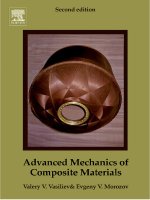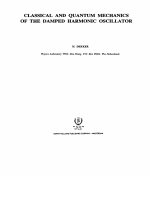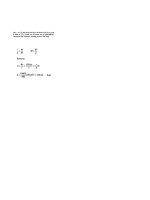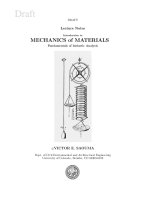- Trang chủ >>
- Khoa Học Tự Nhiên >>
- Vật lý
Mechanics of solids
Bạn đang xem bản rút gọn của tài liệu. Xem và tải ngay bản đầy đủ của tài liệu tại đây (3.56 MB, 384 trang )
MECHANICS
OF SOLIDS
www.pdfgrip.com
This page
intentionally left
blank
www.pdfgrip.com
MECHANICS
OF SOLIDS
S.S. Bhavikatti
Emeritus Fellow (AICTE)
BVB College of Engineering and Technology, Hubli
(Formerly Principal, RYMEC, Bellary
S.S.
Bhavikatti
Professor
& Dean
SDMCET, Dharwad and NITK, Surathkal)
www.pdfgrip.com
Copyright © 2010, New Age International (P) Ltd., Publishers
Published by New Age International (P) Ltd., Publishers
All rights reserved.
No part of this ebook may be reproduced in any form, by photostat, microfilm, xerography,
or any other means, or incorporated into any information retrieval system, electronic or
mechanical, without the written permission of the publisher. All inquiries should be
emailed to
ISBN (13) : 978-81-224-2858-2
PUBLISHING FOR ONE WORLD
NEW AGE INTERNATIONAL (P) LIMITED, PUBLISHERS
4835/24, Ansari Road, Daryaganj, New Delhi - 110002
Visit us at www.newagepublishers.com
www.pdfgrip.com
Preface
Mechanics of Solids is an important course for all engineering students by
which they develop analytical skill. In this course, laws of mechanics are applied
to parts of bodies and skill is developed to get solution to engineering problems
maintaining continuity of the parts.
The author has clearly explained theories involved and illustrated them by
solving a number of engineering problems. Neat diagrams are drawn and
solutions are given without skipping any step. SI units and standard notations
as suggested by Indian Standard Code are used throughout. The author has
made this book to suit the latest syllabus of Gujarat Technical University.
Author hopes, the students and teachers of Gujarat Technical University will
receive this book whole-heartedly as most of the earlier books of the author
have been received by the students and teachers all over India.
The suggestions and corrections, if any, are most welcome.
The author acknowledges the efforts of M/s. New Age International Publishers in bringing out this book in nice form. He also acknowledges the opportunity given by AICTE for associating him with B.U.B. Engineering College,
Hubli.
—Author
(v)
www.pdfgrip.com
This page
intentionally left
blank
www.pdfgrip.com
Contents
Preface
1
INTRODUCTION TO MECHANICS OF SOLIDS
1.1
1.2
1.3
1.4
2
v
Basic Terminologies in Mechanics ............................................................................... 2
Units ............................................................................................................................. 5
Scalar and Vector Quantities ....................................................................................... 6
Composition and Resolution of Vectors ......................................................................... 6
Important Formulae ................................................................................................... 13
Theory Questions ........................................................................................................ 14
Problems for Exercise ................................................................................................. 14
FUNDAMENTALS OF STATICS
2.1
2.2
2.3
2.4
2.5
2.6
2.7
2.8
2.9
2.10
2.11
2.12
2.13
2.14
2.15
2.16
1–14
15–64
Principles of Statics .................................................................................................... 15
System of Forces ......................................................................................................... 18
Moment of a Force ...................................................................................................... 18
Varignon’s Theorem ................................................................................................... 19
Couple ......................................................................................................................... 22
Transfer of a Force to Parallel Position ..................................................................... 23
Composition of Concurrent Coplanar Forces .............................................................. 23
Equilibriant of a Force System .................................................................................. 28
Composition of Coplanar Non-concurrent Force System ........................................... 28
X and Y Intercepts of Resultant ................................................................................. 29
Types of Forces on a Body .......................................................................................... 38
Free Body Diagram .................................................................................................... 40
Equilibrium of Bodies ................................................................................................. 40
Equilibrium of Concurrent Force Systems ................................................................ 41
Equilibrium of Connected Bodies ............................................................................... 47
Equilibrium of Non-concurrent Force Systems ......................................................... 53
Important Formulae ................................................................................................... 57
Theory Questions ........................................................................................................ 58
Problems for Exercise ................................................................................................. 59
www.pdfgrip.com
CONTENTS
3
TRUSSES
3.1
3.2
3.3
3.4
3.5
3.6
4
161–190
Coefficient of Friction ............................................................................................... 161
Laws of Friction ....................................................................................................... 162
Angle of Friction, Angle of Repose and Cone of Friction .......................................... 162
Problems on Blocks Resting on Horizontal and Inclined Planes ............................. 164
Application to Wedge Problems ................................................................................ 174
Application to Ladder Problems ............................................................................... 177
Belt Friction ............................................................................................................. 180
Important Formulae ................................................................................................. 187
Theory Questions ...................................................................................................... 187
Problems for Exercise ............................................................................................... 187
SIMPLE MACHINES
6.1
6.2
6.3
6.4
6.5
94–160
Determination of Areas and Volumes ......................................................................... 94
Centre of Gravity and Centroids ................................................................................ 99
Centroid of a Line ..................................................................................................... 100
First Moment of Area and Centroid ......................................................................... 104
Second Moments of Plane Area ................................................................................ 119
Moment of Inertia from First Principles .................................................................. 122
Moment of Inertia of Composite Sections ................................................................. 129
Theorems of Pappus-Guldinus ................................................................................. 142
Centre of Gravity of Solids ....................................................................................... 146
Important formulae .................................................................................................. 151
Theory Questions ...................................................................................................... 152
Problems for Exercise ............................................................................................... 152
FRICTION
5.1
5.2
5.3
5.4
5.5
5.6
5.7
6
Perfect, Deficient and Redundant Trusses ................................................................ 65
Assumptions ............................................................................................................... 66
Nature of Forces in Members ..................................................................................... 67
Methods of Analysis .................................................................................................... 68
Method of Joints ......................................................................................................... 68
Method of Section ........................................................................................................ 81
Important Formula .................................................................................................... 87
Theory Questions ........................................................................................................ 87
Problems for Exercise ................................................................................................. 88
DISTRIBUTED FORCES, CENTRE OF GRAVITY AND MOMENT
OF INERTIA
4.1
4.2
4.3
4.4
4.5
4.6
4.7
4.8
4.9
5
65–93
191–227
Definitions ................................................................................................................ 191
Practical Machines ................................................................................................... 192
Law of Machine ........................................................................................................ 194
Variation of Mechanical Advantage ......................................................................... 195
Variation of Efficiency .............................................................................................. 195
www.pdfgrip.com
CONTENTS
6.6
6.7
6.8
6.9
6.10
6.11
6.12
6.13
6.14
6.15
7
PHYSICAL AND MECHANICAL PROPERTIES OF
STRUCTURAL MATERIALS
7.1
7.2
8
Reversibility of a Machine ........................................................................................ 199
Lever Arm ................................................................................................................ 200
Pulleys ...................................................................................................................... 201
Wheel and Axle ......................................................................................................... 205
Wheel and Differential Axle ..................................................................................... 205
Weston Differential Pulley Block ............................................................................. 206
Inclined Plane ........................................................................................................... 208
Screw Jack ................................................................................................................ 213
Differential Screw Jack ............................................................................................ 218
Winch Crabs ............................................................................................................. 219
Important Formulae ................................................................................................. 223
Theory Questions ...................................................................................................... 224
Problems for Exercise ............................................................................................... 225
Physical Properties ................................................................................................... 228
Mechanical Properties .............................................................................................. 229
Theory Questions ...................................................................................................... 233
SIMPLE STRESSES AND STRAINS
8.1
8.2
8.3
8.4
8.5
8.6
8.7
8.8
8.9
8.10
8.11
8.12
8.13
8.14
8.15
8.16
8.17
8.18
8.19
8.20
8.21
8.22
228–233
234–282
Meaning of Stress ..................................................................................................... 234
Unit of Stress ........................................................................................................... 236
Axial Stress .............................................................................................................. 236
Strain ........................................................................................................................ 237
Stress-Strain Relation .............................................................................................. 238
Nominal Stress and True Stress .............................................................................. 241
Factor of Safety ......................................................................................................... 242
Hooke’s Law ............................................................................................................. 242
Extension/Shortening of a Bar ................................................................................. 243
Bars with Cross-sections Varying in Steps .............................................................. 246
Bars with Continuously Varying Cross-sections ...................................................... 248
Shear Stress ............................................................................................................. 253
Simple Shear ............................................................................................................ 253
Poisson’s Ratio .......................................................................................................... 255
Volumetric Strain ..................................................................................................... 255
Elastic Constants ...................................................................................................... 256
Relationship between Modulus of Elasticity and Modulus of Rigidity ..................... 257
Relationship between Modulus of Elasticity and Bulk Modulus .............................. 258
Composite/Compound Bars ....................................................................................... 264
Thermal Stresses ...................................................................................................... 269
Thermal Stresses in Compound Bars ....................................................................... 274
Hoop Stresses ........................................................................................................... 277
www.pdfgrip.com
CONTENTS
Important Formulae ................................................................................................. 278
Theory Questions ...................................................................................................... 279
Problems for Exercise ............................................................................................... 280
9
BEAMS
9.1
9.2
9.3
9.4
9.5
9.6
9.7
9.8
9.9
9.10
9.11
283–312
Introduction .............................................................................................................. 283
Types of Supports ..................................................................................................... 283
Types of Beams ......................................................................................................... 284
Types of Loading ....................................................................................................... 285
Reactions from Supports of Beams ........................................................................... 286
Shear Force and Bending Moment ........................................................................... 291
Sign Convention ....................................................................................................... 293
Relationship between Load Intensity, Shear Force and Bending Moment .............. 293
Shear Force and Bending Moment Diagrams .......................................................... 294
SFD and BMD for a few Standard Cases ................................................................. 295
Short-cut Procedure .................................................................................................. 307
Important Formulae ................................................................................................. 310
Theory Questions ...................................................................................................... 310
Problems for Exercise ............................................................................................... 310
10 STRESSES IN BEAMS
10.1
10.2
10.3
10.4
10.5
10.6
10.7
10.8
313–345
Assumptions ........................................................................................................... 314
Bending Equation ................................................................................................... 314
Locating Neutral Axis ............................................................................................ 316
Moment Carrying Capacity of a Section ................................................................. 317
Section Moduli of Standard Sections ...................................................................... 318
Proportioning Sections ............................................................................................ 329
Shear Stress Distribution ....................................................................................... 330
Shear Stresses in Built-up Sections ....................................................................... 338
Important Formulae ................................................................................................. 342
Theory Questions ...................................................................................................... 343
Problems for Exercise ............................................................................................... 343
11 PRINCIPAL STRESSES AND STRAINS
11.1
11.2
11.3
11.4
11.5
346–373
Stresses on Inclined Planes .................................................................................... 346
Principal Stresses and Planes ................................................................................ 348
Principal Stresses in Beams .................................................................................... 360
Principal Strains ...................................................................................................... 365
Measurement of Strain ............................................................................................. 368
Important Formulae ................................................................................................. 371
Theory Questions ...................................................................................................... 372
Problems for Exercise ............................................................................................... 372
www.pdfgrip.com
1
Introduction to
Mechanics of Solids
The state of rest and the state of motion of the bodies under the action of different forces has
engaged the attention of mathematicians and scientists for many centuries. The branch of physical
science that deal with the state of rest or the state of motion of bodies is termed as mechanics.
Starting from the analysis of rigid bodies under gravitational force and application of simple forces
the mechanics has grown into the analysis of complex structures like multistorey buildings, aircrafts,
space crafts and robotics under complex system of forces like dynamic forces, atmospheric forces
and temperature forces.
Archemedes (287–212 BC), Galileo (1564–1642), Sir Issac Newton (1642–1727) and Einstein
(1878–1955) have contributed a lot to the development of mechanics. Contributions by Varignon,
Euler, and D. Alemberts are also substantial. The mechanics developed by these researchers may
be grouped as
(i) Classical mechanics/Newtonian mechanics
(ii) Relativistic mechanics
(iii) Quantum mechanics/Wave mechanics.
Sir Issac Newton, the principal architect of mechanics, consolidated the philosophy and experimental
findings developed around the state of rest and state of motion of the bodies and putforth them in
the form of three laws of motion as well as the law of gravitation. The mechanics based on these
laws is called Classical mechanics or Newtonian mechanics.
Albert Einstein proved that Newtonian mechanics fails to explain the behaviour of high speed
(speed of light) bodies. He putfourth the theory of Relativistic mechanics.
Schrödinger (1887–1961) and Broglie (1892–1965) showed that Newtonian mechanics fails to
explain the behaviour of particles when atomic distances are concerned. They putforth the theory
of Quantum mechanics.
Engineers are keen to use the laws of mechanics to actual field problems. Application of laws
of mechanics to field problems is termed as Engineering mechanics. For all the problems between
atomic distances to high speed distances there are various engineering problems for which Newtonian
mechanics has stood the test of time and hence is the mechanics used by engineers.
The various bodies on which engineers are interested to apply laws of mechanics may be
classified as
(i) Solids and
(ii) Fluids.
1
www.pdfgrip.com
2
MECHANICS OF SOLIDS
The bodies which do not change their shape or size appreciably when the forces are applied
are termed as Solids while the bodies which change their shape or size appreciably even when small
forces are applied are termed as Fluids. Stone, steel, concrete etc. are the example of solids while
water, gases are the examples of fluids.
In this book application of Newtonian mechanics to solids is dealt with.
1.1
BASIC TERMINOLOGIES IN MECHANICS
The following are the terms basic to the study of mechanics, which should be understood clearly.
Mass
The quantity of the matter possessed by a body is called mass. The mass of a body will not change
unless the body is damaged and part of it is physically separated. If the body is taken out in a space
craft, the mass will not change but its weight may change due to the change in gravitational force.
The body may even become weightless when gravitational force vanishes but the mass remain the
same.
Time
The time is the measure of succession of events. The successive event selected is the rotation of
earth about its own axis and this is called a day. To have convenient units for various activities,
a day is divided into 24 hours, an hour into 60 minutes and a minute into 60 seconds. Clocks are
the instruments developed to measure time. To overcome difficulties due to irregularities in the
earths rotation, the unit of time is taken as second which is defined as the duration of 9192631770
period of radiation of the cesium-133 atom.
Space
The geometric region in which study of body is involved is called space. A point in the space may
be referred with respect to a predetermined point by a set of linear and angular measurements. The
reference point is called the origin and the set of measurements as coordinates. If the coordinates
involved are only in mutually perpendicular directions, they are known as cartesian coordination.
If the coordinates involve angles as well as the distances, it is termed as Polar Coordinate System.
Length
It is a concept to measure linear distances. The diameter of a cylinder may be 300 mm, the height
of a building may be 15 m, the distance between two cities may be 400 km.
Actually metre is the unit of length. However depending upon the sizes involved micro, milli or kilo
metre units are used for measurements. A metre is defined as length of the standard bar of
platinum-iradium kept at the International Bureau of weights and measures. To overcome the
difficulties of accessibility and reproduction now metre is defined as 1690763.73 wavelength of
krypton-86 atom.
Continuum
A body consists of several matters. It is a well known fact that each particle can be subdivided
into molecules, atoms and electrons. It is not possible to solve any engineering problem by treating
a body as conglomeration of such discrete particles. The body is assumed to be a continuous
distribution of matter. In other words the body is treated as continuum.
www.pdfgrip.com
3
INTRODUCTION TO MECHANICS OF SOLIDS
Rigid Body
A body is said to be rigid, if the relative positions of any two particles do not change under the
action of the forces acting on it. In Fig. 1.1 (a), point A and B are the original positions in a body.
After the application of forces F1, F2, F3, the body takes the position as shown in Fig. 1.1(b). A′
and B′ are the new positions of A and B. If the body is treated as rigid, the relative position of A′B′
and AB are the same i.e.
A′B′ = AB
Many engineering problems can be solved by assuming bodies rigid
F2
B
B′
A′
A
F1
(a)
F3
(b)
Fig. 1.1
Particle
A particle may be defined as an object which has only mass and no size. Theoretically speaking
such a body cannot exist. However in dealing with problems involving distances considerably larger
compared to the size of the body, the body may be treated as a particle, without sacrificing
accuracy.
For example:
— A bomber aeroplane is a particle for a gunner operating from the ground.
— A ship in mid sea is a particle in the study of its relative motion from a control tower.
— In the study of movement of the earth in celestial sphere, earth is treated as a particle.
Force
Force is an important term used in solid mechanics. Newton’s first law states that everybody
continues in its state of rest or of uniform motion in a straight line unless it is compelled by an
external agency acting on it. This leads to the definition of force as ‘force is an external agency
which changes or tends to change the state of rest or uniform linear motion of the body’.
Magnitude of force is defined by Newton’s second law. It states that the rate of change of
momentum of a body is directly proportional to the impressed force and it takes place in the
direction of the force acting on it. Noting that rate of change of velocity is acceleration, and the
product of mass and velocity is momentum we can derive expression for the force as given below:
From Newton’s second law of motion
Force ∝ rate of change of momentum
∝ rate of change of (mass × velocity)
www.pdfgrip.com
4
MECHANICS OF SOLIDS
Since mass do not change,
Force ∝ mass × rate of change of velocity
∝ mass × acceleration
F ∝ m × a
...(1.1)
= k × m × a
where F is the force, m is the mass and a is the acceleration and k is the constant of proportionality.
In all the systems, unit of force is so selected that the constant of the proportionality becomes
unity. For example, in S.I. system, unit of force is Newton, which is defined as the force that is
required to move one kilogram (kg) mass at an acceleration of 1 m/sec2.
∴
One newton = 1 kg mass × 1 m/sec2
Thus
k = 1
F = m × a
...(1.2)
2
However in MKS acceleration used is one gravitational acceleration (9.81 m/sec on earth
surface) and unit of force is defined as kg-wt.
Thus
F in kg wt = m × g
...(1.3)
Thus
1 kg-wt = 9.81 newtons
...(1.4)
It may be noted that in usage kg-wt is often called as kg only.
Characteristics of a Force
www.pdfgrip.com
600 N
C
2m
It may be noted that a force is completely specified only when the
following four characteristics are specified
— Magnitude
— Point of application
— Line of action
— Direction.
In Fig. 1.2, AB is a ladder kept against a wall. At point C, a person
weighing 600 N is standing. The force applied by the person on the
ladder has the following characters:
— magnitude is 600 N
— the point of application is C which is at 2 m from A along the
ladder
— the line of action is vertical
— the direction is downward.
It may be noted that in the figure
— magnitude is written near the arrow
— the line of arrow shows the line of application
— the arrow head shows the point of application
— the direction of arrow represents the direction of the force.
A
Fig. 1.2
B
5
INTRODUCTION TO MECHANICS OF SOLIDS
1.2
UNITS
Length (L), mass (M) and time (S) are the fundamental units used in mechanics. The units of all
other quantities may be expressed in terms of these basic units. The three commonly used systems
are
— Metre, Kilogram, Second (MKS)
— Centimetre, Gram, Second (CGS)
— Foot, Pound, Second (FPS).
The systems are named after the units used to define the fundamental quantities length, mass
and time. Using these basic units, the units of other quantities can be found. For example in MKS
the units for various quantities are
Quantity
Unit
Area
m2
Volume
m3
Velocity
m/sec
Acceleration
m/sec2
Momentum
kg-m/sec
[Since it is = mass × velocity]
2
Force
kg-m/sec
[Since it is = mass × acceleration]
S.I. Units
Presently the whole world is in the process of switching over to SI-system of units. SI units stands
for the System International d′ units or International System of units. As in MKS units in SI also
the fundamental units are metre for length, kilogram for mass and second for time. The difference
between MKS and SI system arises mainly in selecting the unit of force. In MKS unit of force is
kg-wt while in SI units it is newton. As we have already seen one kg-wt is equal to 9.81 newtons.
The prefixes used in SI when quantities are too big or too small are shown in Table 1.1.
Table 1.1. Prefixes in SI Units
Multiplying Factors
Prefix
1012
tera
T
109
giga
G
10
6
mega
M
10
3
kilo
k
—
—
10
milli
m
10–6
micro
m
–9
nano
n
–12
10
pico
p
10–15
femto
f
atto
a
100
–3
10
–18
10
www.pdfgrip.com
Symbol
6
1.3
MECHANICS OF SOLIDS
SCALAR AND VECTOR QUANTITIES
Various quantities used in mechanics may be grouped into scalars and vectors. A quantity is said
to be scalar, if it is completely defined by its magnitude alone. Examples of scalars are length, area,
time and mass.
A quantity is said to be vector if it is completely defined only when its magnitude as well as
direction are specified. The example of vectors are displacement, velocity, acceleration, momentum,
force etc.
1.4
COMPOSITION AND RESOLUTION OF VECTORS
The process of finding a single vector which will have the same effect as a set of vectors acting
on a body is known as composition of vectors. The resolution of vectors is exactly the opposite
process of composition i.e., it is the process of finding two or more vectors which will have the
same effect as that of a vector acting on the body.
Parallelogram Law of Vectors
The parallelogram law of vectors enables us to determine the single vector called resultant vector
which can replace the two vectors acting at a point with the same effect as that of the two vectors.
This law was formulated based on exprimental results on a body subjected to two forces. This law
can be applied not only to the forces but to any two vectors like velocities, acceleration, momentum
etc. Though stevinces employed it in 1586, the credit of presenting it as a law goes to Varignon
and Newton (1687). This law states that if two forcer (vectors) acting simultaneously on a body
at a point are represented in magnitude and directions by the two adjacent sides of a parallelogram,
their resultant is represented in magnitude and direction by the diagonal of the parallelogram which
passes thorough the point of intersection of the two sides representing the forces (vectors).
In the Fig. 1.3, the force F1 = 4 units and the force F2 = 3 unit are acting on a body at a
point A. To get the resultant of these forces, according to this law, construct the parallelogram
ABCD such that AB is equal to 4 units to the linear scale and AC is equal to 3 units. Then according
to this law, the diagonal AD represents the resultant in magnitude and direction. Thus the resultant
of the forces F1 and F2 is equal to the units corresponding to AD in the direction α to F1.
C
D
R
F2
3
θ
R
θ
α
F1
A
B
4
(a)
(b)
Fig. 1.3
www.pdfgrip.com
(c)
7
INTRODUCTION TO MECHANICS OF SOLIDS
Triangle Law of Vectors
Referring to Fig. 1.3 (b), it can be observed that the resultant AD may be obtained by constructing
the triangle ABD. Line AB is drawn to represent F1 and BD to represent F2. Then AD should
represent the resultant of F1 and F2. Thus we have derived the triangle law of forces from the
fundamental law of parallelogram. The Triangle Law of Forces (vectors) may be stated as if two
forces (vectors) acting on a body are represented one after another by the sides of a triangle, their
resultant is represented by the closing side of the triangle taken from the first point to the last point.
Polygon Law of Forces (Vectors)
If more than two forces (vectors) are acting on a body, two forces (vectors) at a line can be
combined by the triangle law, and finally resultant of all forces (vectors) acting on the body may
be obtained.
A system of four concurrent forces acting on a body are shown in Fig. 1.4. AB represents F1
and BC represent F2. Hence according to triangle law of forces AC represents the resultant of F1
and F2, say R1.
E
F4
F3 = 30 kN
D
F4 = 30 kN
R
F2 = 25 kN
C
F1 = 20 kN
O
F3
R2
R1
A
F1
F2
B
Fig. 1.4
If CD is drawn to represent F3, then from the triangle law of forces AD represents the resultant
of R1 and F3. In other words, AD represents the resultant of F1, F2 and F3. Let it be called as R2.
Similarly the logic can be extended to conclude that AE represents the resultant of F1, F2, F3
and F4. The resultant R is represented by the closing line of the polygon ABCDE in the direction
form A to E. Thus we have derived the polygon law of the forces (vectors) and it may be stated
as if a number of concurrent forces (vectors) acting simultaneously on a body are represented in
magnitude and direction by the sides of a polygon, taken in a order, then the resultant is represented
in magnitude and direction by the closing side of the polygon, taken from the first point to the last
point.
Analytical Method of Composition of Two Vectors
Parallelogram law, triangle law and polygonal law of vectors can be used to find the resultant
graphically. This method gives a clear picture of the work being carried out. However the main
disadvantage is that it needs drawing aids like pencil, scale, drawing sheets. Hence there is need for
analytical method.
www.pdfgrip.com
8
MECHANICS OF SOLIDS
Consider the two forces F1 and F2 acting on a particle as shown in Fig 1.5(a). Let the angle
between the two forces be θ. If parallelogram ABCD is drawn as shown in Fig. 1.5(b) with AB
respresenting F1 and AD representing F2 to some scale, according to parallelogram law of forces
AC represents the resultant R. Drop perpendicular CE to AB.
D
C
F2
F2
R
F2
q
q
O
A
F1
q
a
F1
(a)
B
E
(b)
Fig. 1.5
The resultant R of F1 and F2 is given by
R = AC =
But
AE 2 + CE 2 = ( AB + BE) 2 + CE 2
AB = F1
BE = BC cos θ = F2 cos θ
CE = BC sin θ = F2 sin θ
∴
Since,
R =
( F1 + F2 cos θ) 2 + ( F2 sin θ) 2
=
F1 2 + 2 F1 F2 cos θ + F2 2 cos 2 θ + F2 2 sin 2 θ
=
F1 2 + 2 F1 F2 cos θ + F2 2
sin2 θ + cos2 θ = 1.
The inclination of resultant to the direction of F1 is given by α, where
tan α =
Hence
CE
CE
F2 sin θ
=
=
AE AB + BE F1 + F2 cos θ
α = tan–1
F2 sin θ
F1 + F2 cos θ
Particular cases:
1. When θ = 90° [Ref. Fig. 1.6a],
R =
F12 + F2 2
2. When θ = 0° [Ref. Fig. 1.6b],
R =
F12 + 2 F1 F2 2 + F2 2 = F1 + F2
3. When θ = 180° [Ref. Fig. 1.6c],
R =
F1 2 − 2 F1 F2 + F2 2 = F1 – F2
www.pdfgrip.com
9
INTRODUCTION TO MECHANICS OF SOLIDS
F2
R
F1
F1
F1
F2
F2
(c)
(b)
(a)
Fig. 1.6
Resolution of Vectors
Since the resolution of vectors is exactly opposite process of composition of vectors, exactly the
opposite process of composition can be employed to get the resolved components of a given force.
F1
β
F
F
β F2
α
θ=α+β
α
F1
F2
(a)
Fy
F
F
Fy
F2
Fx
(b)
F4
F3
F
F
F2
F4
F1
F3
F2
F1
(c)
Fig. 1.7
In Fig. 1.7(a), the given force F is resolved into two components making angles α and β with F.
In Fig. 1.7(b) the force F is resolved into its rectangular components Fx and Fy.
In Fig. 1.7(c), the force F is resolved into its four components F1, F2, F3 and F4.
It may be noted that all component forces act at the same point as the given force. Resolution
of forces into its rectangular components is more useful in solving the problems in mechanics. In
this case, if the force F makes angle θ with x-axis, from Fig. 1.7(a), it is clear that
Fx = F cos θ and Fy = F sin θ.
www.pdfgrip.com
10
MECHANICS OF SOLIDS
Example 1.1. A boat is rowed at a velocity of 20 km/hour across a river. The velocity of stream
is 8 km/hour. Determine the resultant velocity of the boat.
Solution: Taking downstream direction as x and direction across the river as y, it is given that
Vx = 8 km/hour
Vy = 20 km/hour
∴ The resultant velocity
V =
82 + 20 2 = 21.54 km/hour
Vy =20 km/hour
α = tan–1
Vy
= tan–1
Vx
20
= 68.20°, as shown in Fig. 1.8
8
Downstream
V
a
Vx = 8 km/hour
Fig. 1.8
20
k
N
Example. 1.2. The guy wire of the electrical pole shown in Fig. 1.9(a) makes 60° to the horizontal
and is carrying a force of 60 kN. Find the horizontal and vertical components of the force.
F
60°
Fy
60°
Fx
(b)
(a)
Fig. 1.9
Solution: Figure 1.9(b) shows the resolution of force F = 20 kN into its components in horizontal
and vertical components. From the figure it is clear that
Fx = F cos 60° = 20 cos 60° = 10 kN (to the left)
Fy = F sin 60° = 20 sin 60° = 17.32 kN (downward)
www.pdfgrip.com
11
INTRODUCTION TO MECHANICS OF SOLIDS
Example 1.3. A black weighing W = 10 kN is resting on an inclined plane as shown in Fig.
1.10(a). Determine its components normal to and parallel to the inclined plane.
A
70°
20°
20°
(a)
20°
W
B
C
(b)
Fig. 1.10
Solution: The plane makes an angle of 20° to the horizontal. Hence the normal to the plane makes
an angles of 70° to the horizontal i.e., 20° to the vertical [Ref. Fig. 1.10(b)]. If AB represents the
given force W to some scale, AC represents its component normal to the plane and CB represents
its component parallel to the plane.
Thus from ∆ ABC,
Component normal to the plane
= AC
= W cos 20°
= 10 cos 20°
= 9.4 kN as shown in Fig. 1.10(b)
Component parallel to the plane
= W sin 20° = 10 sin 20°
= 3.42 kN, down the plane
From the above example, the following points may be noted:
1. Imagine that the arrow drawn represents the given force to some scale.
2. Travel from the tail to head of arrow in the direction of the coordinates selected.
3. Then the direction of travel gives the direction of the component of vector.
4. From the triangle of vector, the magnitudes of components can be calculated.
Example 1.4. The resultant of two forces, one of which is double the other is 260 N. If the direction
of the larger force is reversed and the other remain unaltered, the magnitude of the resultant
reduces to 180 N. Determine the magnitude of the forces and the angle between the forces.
Solution: Let the magnitude of the smaller force be F. Hence the magnitude of the larger force is
2F.
Thus
F1 = F and F2 = 2F
Let θ be the angle between the two forces.
∴ From the condition 1, we get
R =
i.e.,
F1 2 + 2 F1 F2 cos θ + F2 2 = 260
F2 + 2F (2F) cos θ + (2F)2 = 2602
5F2 + 4F2 cos θ = 67600
www.pdfgrip.com
...(i)
12
MECHANICS OF SOLIDS
From condition 2, we get
F1 2 + 2 F1 F2 cos (180 + θ) + F2 2 = 180
F2 – 2F(2F) cos θ + (2F)2 = 32400
Adding equation (i) and (ii), we get
10F2 = 100000
∴
F = 100 N
Hence
F1 = F = 100 N; F2 = 2F = 200 N
Substituting the values of F1 and F2 in eqn (i), we get,
5(100)2 + 4(100)2 cos θ = 67600
∴
cos θ = 0.44
θ = 63.9°
or
...(ii)
Example 1.5. Two forces F1 and F2 are acting at point A as
shown in Fig. 1.11. The angle between the two forces is 50°.
F2
It is found that the resultant R is 500 N and makes angles 20°
R
with the force F1 as shown in the figure. Determine the forces
0°
5
q = 20°
F1 and F2.
a=
F1
A
Solution: Let ∆ ABC be the triangle of forces drawn to some
Fig. 1.11
scale. In this
∠BAC = α = 20°
∠ABC = 180 – 50 = 130°
∴
∠ACB = 180 – (20 + 130) = 30°
Applying sine rule to ∆ ABC, we get
C
50°
B
AB
BC
500
=
=
sin 30° sin 20° sin 130°
∴
and
Thus
and
AB
BC
F1
F2
=
=
=
=
326.35 N
223.24 N.
AB = 326.35 N
BC = 223.24 N
Example 1.6. The resultant of two forces F1 = 400 N and
F2 = 260 N acting at point A is 520 N. Determine the
angle between the two forces and the angle between the
resultant and force F1.
Solution: Let ABC be the triangle of forces as shown in
Fig. 1.12. θ be the angle between F1 and F2, and α be the
angle between resultant and F1
Using the relation
R =
C
F2
R=
N
F2 = 260 N
q
a
A
F1= 400 N
Fig. 1.12
F1 2 + F2 2 + 2 F1 F2 cos θ ,
we get,
5202 = 4002 + 2602 + 2 × 400 × 260 × cos θ
www.pdfgrip.com
520
B
13
INTRODUCTION TO MECHANICS OF SOLIDS
∴
∴
Noting that
cos θ = 0.20577
θ = 78.13°
R sin α = F2 sin θ
260 sin 78.13°
= 0.489
520
α = 29.29°
sin α =
we get
∴
Example 1.7. Fig. 1.13 shows a particular position of 200 mm connecting rod AB and 80 mm long
crank BC. At this position, the connecting rod of the engine experience a force of 3000 N on the
crank pin at B. Find its
(a) horizontal and vertical component
(b) component along BC and normal to it.
Vertical
Connecting rod
B
80
60°
3000 N
60°
mm
0
20
a
Crank
mm
a
Horizontal
C
A
(b)
(a)
Fig. 1.13
Solution: The force of 3000 N acts along line AB. Let AB make angle α with horizontal. Then,
obviously 200 sin α = 80 sin 60°
∴
α = 20.268°
Referring to Fig. 1.13(b), we get
Horizontal component
= 3000 cos 20.268° = 2814.2 N
Vertical component
= 3000 sin 20.268° = 1039.2 N
Components along and normal to crank:
The force makes angle α + 60° = 20.268 + 60 = 80.268° with crank.
∴ Component along crank
= 3000 cos 80.268° = 507.1 N
Component normal to crank
= 3000 sin 80.268° = 2956.8 N
IMPORTANT FORMULAE
1. Resultant of two vectors can be obtained by solving the triangle of forces.
2. If V1 and V2 are the two vectors at angle ‘θ’ between them, then the resultant is
R =
V12 + V2 2 + 2V1V2 cos θ
www.pdfgrip.com
14
MECHANICS OF SOLIDS
and acts at ‘α’ to V1 vector, where
tan α =
V2 sin α
V1 + V2 cos α
Vectors may be forces, velocities, momentum etc.
3. If a force makes angle θ with x-axis, then its components are
Fx = F cos θ
Fy = F sin θ.
4. If a body weighing W rests on an inclined plane, its components normal to and parallel to the plane
are
Fn = W cos θ, a thrust on the plane.
Ft = W sin θ, down the plane.
THEORY QUESTIONS
1. Explain the following terms:
(i) Space
(ii) Continuum
(iii) Particle
(iv) Rigid body.
2. Explain the term ‘Force’ and list its characteristics.
3. Distinguish between
(i) MKS and SI units
(ii) Scalars and vectors.
4. State and explain parallelogram law of vectors.
5. State parallelogram law of vector and derive triangle and polygonal law of vectors.
PROBLEMS FOR EXERCISE
1. The resultant of two forces one of which is 3 times the other is 300 N. When the direction of
smaller force is reversed, the resultant is 200 N. Determine the two forces and the angle between
them.
[Ans. F1 = 80.6 N, F2 = 241.8 N, θ = 50.13°]
2. A rocket is released from a fighter plane at an angle upward 20° to the vertical with an acceleration
of 8 m/sec2. The gravitational acceleration is 9.1 m/sec2 downward. Determine the instantaneous
acceleration of the rocket when it was fired.
[Ans. 9.849 m/sec2, θ = 49.75° to vertical]
www.pdfgrip.com









